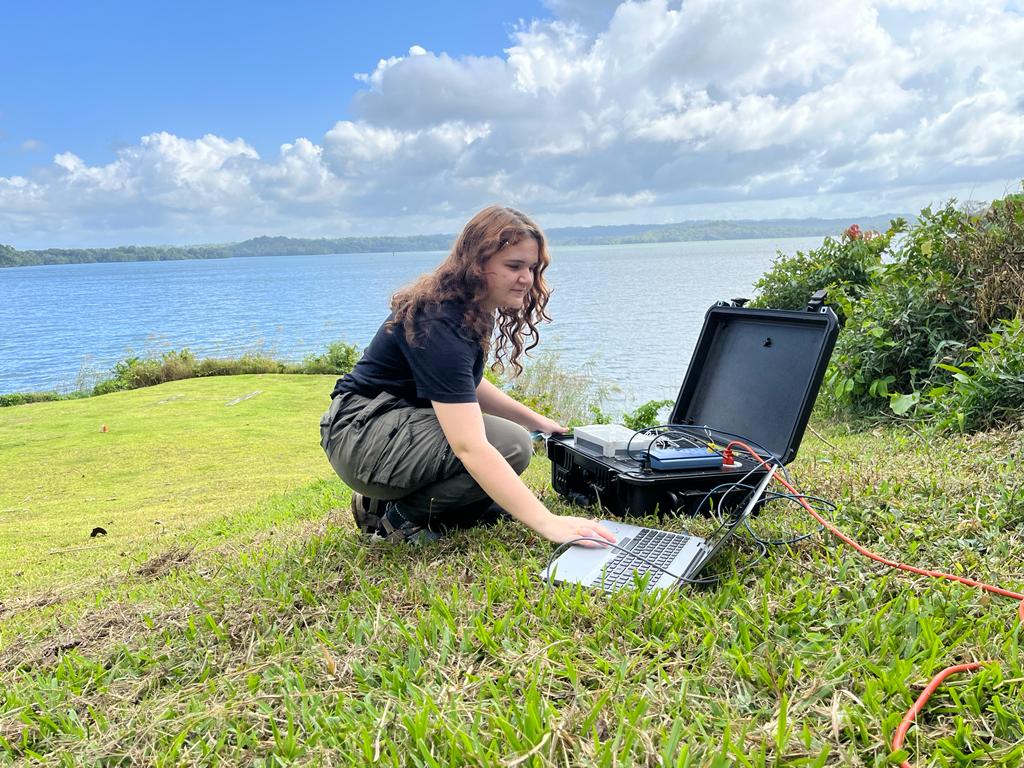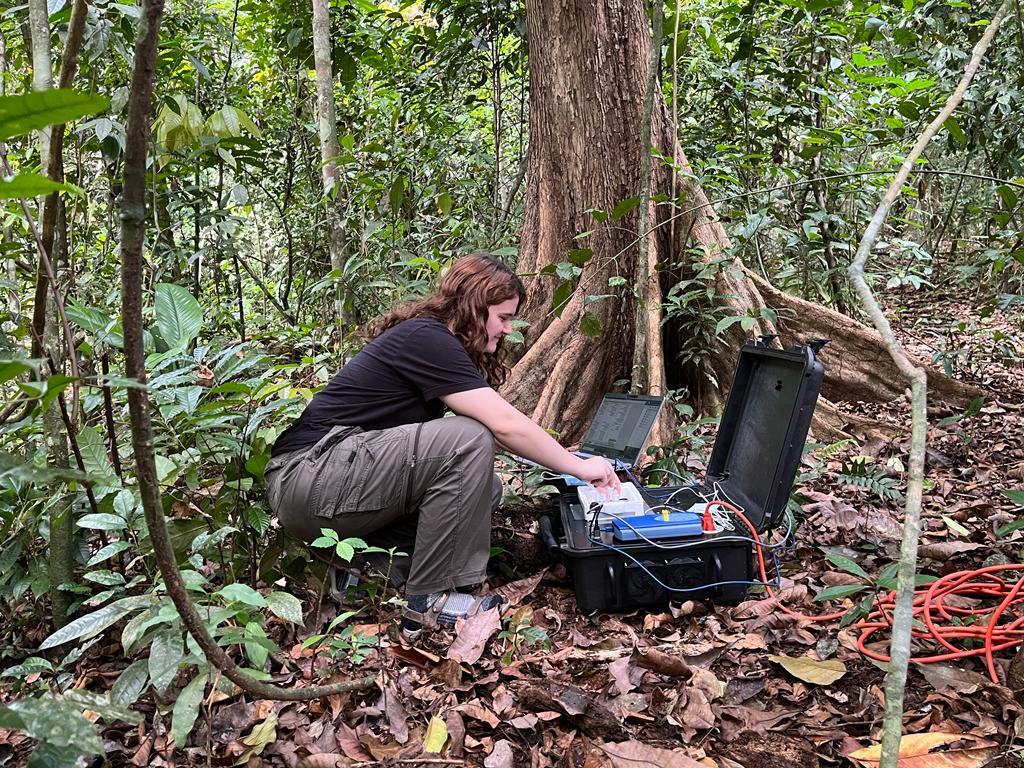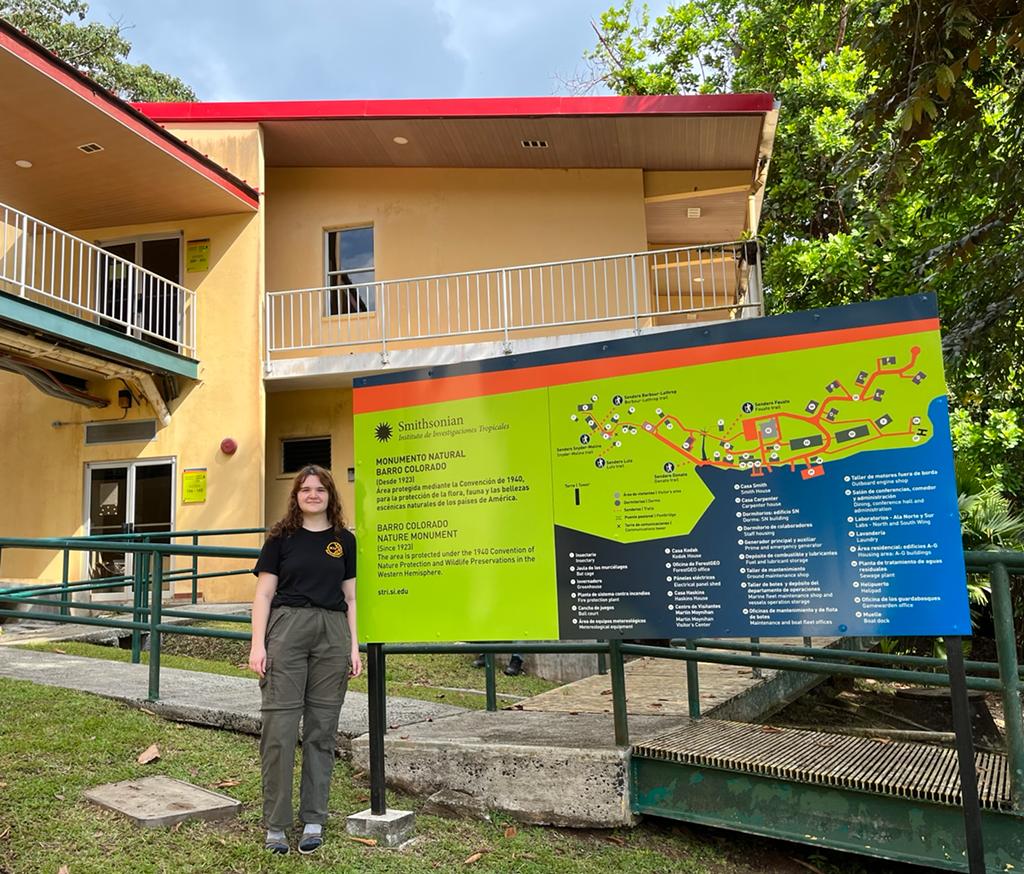KU Biology Student Researcher: Rachel Manweiler

Rachel Manweiler is a 5 year senior majoring in Ecology, Evolution, & Organismal Biology with a minor in Physics. She is also being inducted into the Sigma Pi Sigma Physics Honors Society.
Rachel’s Research Abroad
 This winter Rachel went to Barro Colorado Island, Panama, a field station of the Smithsonian Tropical Research Institute (STRI).
This winter Rachel went to Barro Colorado Island, Panama, a field station of the Smithsonian Tropical Research Institute (STRI).
“On Barro Colorado Island I worked directly with Dr. Victor Gonzalez and Dr. Adam Smith. We were working in Dr. Bill Wcislo’ s lab on the bee Megalopta genalis. [Megalopta genalis is a] really cool species of bee on the island thats nocturnal. [...] We know that climate change is occurring and that our days are getting warmer, but our nights are also getting much warmer. We wanted to see what was happening to populations that were mainly active during the night. We went to study the thermal minimum and the thermal maximum of Megalopta genalis and see if it’s different from bees that forage during the daytime.
We would go out during the day when the bees are inactive and collect the entire nest [then] bring them back to the lab. In the lab we would take [the bees] out of their nest and put them in vials. [Using a] machine called the Elara. [...] we decreased the temperature until the bees reached their thermal minimum, which made them fall asleep and become immobile. After that we would let them recuperate, then put them back [in the Elara} and raise the temperature until they reach their thermal maximum.”
The research had Conclusive Results!
Both the thermal maximum and thermal minimum were lower in Megalopta genalis, than the diurnal bees (bees awake during the day).
Rachel’s Research at KU
“I work with Dr. Jamie Walters on Ophryocystis elektroscirrha. I was introduced to his lab by his then graduate student (now Dr.) Andrew Mongue.
I’m working on my honors thesis which involves the genomics of a parasite of the monarch butterfly. [...] What I’ve been doing is expanding upon what the lab has done in the past. The lab had previously tried to sequence the Ophryocystis elektroscirrha genome but its incredibly difficult. It took an hour and a half of manual labor to try to get the spores open so we could collect the DNA, and then after opening the spores they only got enough DNA for one sequence event.
I’ve been working for the past 2 to 3 years on an effective way to actually open the spores and then [finding] how we can improve the quality of the genome after it has already been assembled. I’ve done both of those things now. I came up with a pretty effective disruption protocol which only involves 6 minutes of bead-beating.
After that, I took the Ophryocystis elektroscirrha assembly we got previously from the lab and worked to improve it with RNA sequence data. I re-scaffolded it and made the genome more contiguous, which means it will be a better starting point for gene models and other research we want to do with the Ophryocystis elektroscirrha genome.”
What does your research look like on a day-to-day basis?
“There are two camps within the project. Trying to get DNA extraction working and then improving the genome.
Extraction: I did this huge 15 trial assay to figure out which was the best way to open the [spores]. I would go in, do whatever procedure was needed to open them, and then the next day I would look at the spores to see if they were disrupted or not and then I would go through and do DNA extraction.
Now we are working on doing the preparations to do the DNA sequencing. We have the Ophryocystis elektroscirrha sample as well as spore samples from a Helicoverpa moth species that we were given, so were are going to work on sequencing both of those. Then look at those results and try to assemble and compare the genomes of both spore samples. . That won’t be part of my thesis because it takes a lot of effort.
Bio-informatics: We are improving the genome we already have. All that could be done on the computer, so I would have my meetings with Dr. Walters and work on the ITTC cluster at KU. I had the program run and align our RNA-sec data to the genome, and that happened fairly quickly. After that I used different tools to get qualitative and quantitative measure of genome improvement.
We looked at the N-50 and Busco scores, and the number and lengths of contigs, and that kind of stuff to see what actually happened to the genome. We got slight improvements. But an improvement is an improvement.”
What’s something interesting you’ve learned from the research?
“The thing I am really grateful to have learned from the research project is that science is not ‘Here’s the start. Here’s the end. And you go directly to the end.’
The project has taken so long because there have been so many issues. And there has been so much disappointment, but I think its super helpful, because that’s the reality of science. You try to do something, and you learn just as much from the things that don’t work than the things that do work, and your probably learn more from the things that don’t work.
So, I know a million and one ways to NOT open Ophryocystis elektroscirrha and now I know a very effective way to open it. I’m happy I got the experience of ‘don’t be disappointed if something doesn’t work now‘ as opposed to later in my career, when I’m trying to do my doctoral work or my post-doctoral work and I’m frustrated. I got all of that out now, I know how it works and I know it’s okay.”

Rachel will be graduation from KU Spring 2022!
This summer Rachel will be working with Dr. Margarita López-Uribe, on the NSF funded IRES project Pollinators in Changing Climates: Colombia. The project is run through Penn State and Universidad Militar Nueva Granada in Colombia.
In fall Rachel will start working as a lab technician in Dr. Gene Robinson’s lab at the University of Illinois.